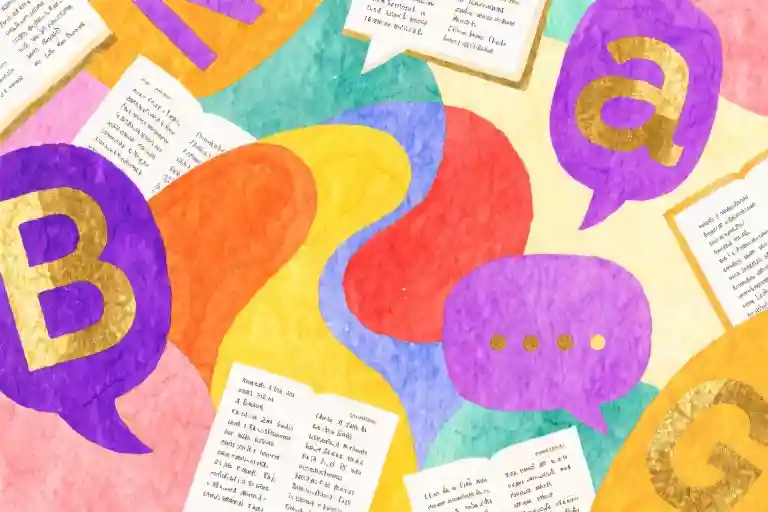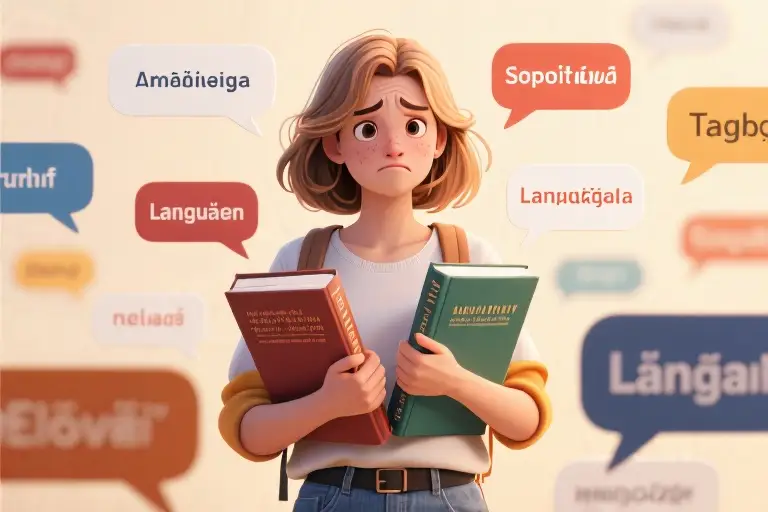For years, I carried the weight of language learning guilt in my handbag – literally. Between the lipsticks and receipts hid color-coded grammar books that symbolized my obsession with “proper” language acquisition. Like many learners, I believed fluency required monastic devotion: hours of daily study, perfect pronunciation drills, and textbook mastery. Then came the humid afternoon in a Parisian café that shattered this illusion forever.
As the barista rapid-fired questions about my coffee order, my meticulously memorized French grammar evaporated. I stood frozen, mentally flipping through textbook pages while the queue behind me grew impatient. In that moment, I realized what decades of academic language learning hadn’t taught me: real communication has little to do with perfect conjugations and everything to do with adaptable, sustainable practice.
This revelation led me to microlearning – the unglamorous but revolutionary approach of consistent, bite-sized language practice. Through personal experimentation and cognitive science research, I discovered that ten focused minutes daily often yield better results than sporadic marathon sessions. The secret lies in how our brains actually retain information, not how we romanticize the learning process.
If you’ve ever:
- Abandoned language apps because “30-minute lessons” felt overwhelming
- Felt guilty about “wasted” days without study
- Questioned whether short practice sessions could actually work
You’re not failing at language learning – the traditional system is failing you. Modern neuroscience confirms that brief, frequent exposure to material creates stronger neural pathways than infrequent, lengthy sessions. It’s why you remember childhood jingles but forget yesterday’s meeting details.
My transition from grammar purist to microlearning advocate wasn’t immediate. Like any reformed perfectionist, I initially dismissed “just ten minutes” as insufficient. But when parenting, work demands, and health challenges made hour-long study sessions impossible, microlearning became my lifeline – and unexpectedly, my most effective method. Those stolen moments added up: toothpaste-flecked vocabulary reviews, grocery line flashcards, kitchen counter pronunciation drills while waiting for tea.
The breakthrough came months later when I effortlessly described my Turkish neighbor’s purple handbag (“Bu çanta mor”) without conscious translation. This unplanned fluency moment proved what research shows: microlearning works because it mirrors how our brains naturally acquire language – through repeated, meaningful exposure in digestible chunks.
What makes microlearning different isn’t just the time commitment, but the psychological freedom it provides. By removing the pressure of lengthy sessions, we create space for curiosity and consistency to flourish. Whether you’re a busy professional, exhausted parent, or chronic over-committer, this approach adapts to your reality rather than demanding you reshape your life around language study.
In the following sections, we’ll explore:
- The cognitive science behind why microlearning outperforms traditional methods
- Customizable 10-minute routines for different proficiency levels
- Strategies for maintaining momentum when life interrupts
- Realistic progress expectations and success markers
But first, let’s address the elephant in the room: can ten minutes really make a difference? The answer lies not in the clock, but in what neuroscientists call “effective learning time” – those precious moments when your brain is fully engaged. One focused minute of active recall often achieves more than ten passive minutes of half-hearted listening. That’s the microlearning advantage.
As we embark on this journey together, I invite you to release the all-or-nothing mindset that sabotages so many language learners. The path to fluency isn’t paved with perfect study days, but with consistent, compassionate effort – one intentional ten-minute session at a time.
Why Traditional Methods Set Us Up for Failure
Language learning often feels like trying to fill a bathtub with a teaspoon—we pour in effort but never seem to make meaningful progress. The truth is, it’s not about how much water you add, but how consistently you do it without spilling half the contents along the way.
The Paris Café Wake-Up Call
There I stood, clutching my meticulously highlighted French grammar book, utterly paralyzed when the barista asked, “Voulez-vous votre café avec un peu de cannelle?” My mind raced through conjugation charts while my mouth produced something between a cough and “Oui… non… pardon?” The cinnamon question wasn’t in any textbook. That moment exposed the fatal flaw of traditional learning: we master systems but fail at communication.
This wasn’t an isolated incident. Last summer, my Turkish neighbor complimented my simit (a sesame bread ring), and I responded with a verb declension table. Her confused smile still haunts me.
The App Trap
Modern solutions promised salvation. I became that person with seventeen language apps, each sending guilt-inducing notifications:
- “Your 157-day streak is in danger!”
- “Juan missed you today!” (Who’s Juan?)
- “Only 1% of learners reach this level!”
The pressure turned learning into a chore. Soon, I’d open Duolingo just to close it immediately—a hollow victory maintaining streaks without retaining anything. Research by language app Memrise reveals 60% of users abandon apps within two weeks, not due to difficulty, but the psychological weight of perceived failure.
The Time Myth
Here’s the uncomfortable truth: the average working adult has just 12-18 minutes of truly discretionary time daily for learning (Journal of Adult Education, 2022). Yet most language courses demand 45-90 minute sessions. It’s like requiring someone to run a marathon when they only have energy for a stroll.
We’ve been conditioned to believe that:
- Longer = Better: That three-hour Saturday study session? Your brain retains less than 20% of it by Monday (Cognitive Science Society).
- Perfection = Progress: Obsessing over flawless grammar prevents actual conversation.
- Immersion = Relocation: As if daily life doesn’t offer countless micro-immersion opportunities.
My turning point came when I noticed my then 4-year-old learned English not through lessons, but through:
- Singing “Head, Shoulders” during diaper changes
- Naming colors while sorting laundry
- Counting apples at the grocery store
These weren’t study sessions—they were life moments repurposed. And they worked better than any textbook.
The Vicious Cycle
Traditional methods create a self-defeating pattern:
- Unrealistic Goals: “I’ll study an hour daily!” (Spoiler: You won’t.)
- Missed Sessions: Life intervenes, guilt accumulates.
- All-or-Nothing Mindset: “Since I skipped Tuesday, I’ll wait until next Monday to restart.”
- Eventual Abandonment: The gap grows until starting over feels impossible.
Neuroscience confirms what experience taught me: your brain learns languages best through frequent, brief exposures—exactly what microlearning provides. In the next section, we’ll explore how to transform those stolen minutes into real progress.
The Brain’s 3 Favorite Learning Secrets
Here’s something fascinating I discovered after years of language struggles: our brains don’t actually want marathon study sessions. They crave short, focused bursts of learning – and science proves it. When I finally understood these three cognitive principles, my 10-minute daily practice became more effective than my previous hour-long study marathons.
1. Spaced Repetition: The Forget-to-Remember Trick
My Turkish color vocabulary breakthrough happened thanks to a counterintuitive method called spaced repetition. Instead of cramming all the color words in one exhausting session (like I used to do), I practiced them for just 2-3 minutes daily using the Anki app. The magic? The app showed me each word precisely when I was about to forget it – maybe three days after first learning “mor” (purple), then a week later, then two weeks.
This technique works because of something called the “forgetting curve.” Our brains naturally discard information we don’t use. But by strategically reviewing material right before we’d normally forget it, we trick our memory into thinking “This must be important!” and retain it longer. It’s like strength training for your brain – short, regular workouts build stronger “memory muscles” than occasional heavy lifting.
2. Chunking: From Word Salad to Practical Phrases
Early in my Italian journey, I made a classic mistake: trying to memorize 100 isolated vocabulary words. Not only was this painfully boring, but when I actually needed to order coffee in Milan, my brain served up random words like a malfunctioning vending machine. That’s when I discovered chunking – grouping information into meaningful, usable blocks.
Instead of separately learning:
- “Vorrei” (I would like)
- “comprare” (to buy)
- “questo” (this)
I memorized the complete phrase “Vorrei comprare questo, per favore” as a single unit. Suddenly, I could actually use Italian in real situations. The brain loves patterns and context – it’s why we remember song lyrics better than random word lists. Now, whenever I learn new material, I ask: “What practical chunk can I create with this?” Maybe it’s:
- A coffee order
- A self-introduction
- Directions to the bathroom
These ready-to-use language “Lego blocks” make communication possible even with limited vocabulary.
3. Active Recall: Why Teaching My Dog Works Better Than Flashcards
Here’s my most embarrassing (but effective) learning secret: I practice new vocabulary by teaching it to my pug Patrick. There’s solid science behind this silly habit – it’s called active recall, and it’s dramatically more effective than passive review.
When I simply reread flashcards, I create the illusion of learning. But when I try to explain Turkish color words to Patrick without looking at my notes, I’m forcing my brain to retrieve and reconstruct the information. This mental effort – though sometimes frustrating – creates stronger neural pathways. Research shows active recall can improve retention by up to 50% compared to passive study methods.
Other active recall techniques I use:
- Covering the answers during flashcard review
- Writing sentences from memory before checking grammar
- Recording myself speaking without notes
The key is creating situations where you must generate the language rather than just recognize it. It’s the difference between watching someone play tennis and actually swinging the racket yourself.
Putting It All Together: My 10-Minute Science Stack
Here’s how these three principles combine in my daily microlearning sessions:
- Spaced Repetition (3 minutes): Quick Anki review of words/phrases due for practice
- Chunking (4 minutes): Learn or review one practical language “block” (like ordering food)
- Active Recall (3 minutes): Try using the new chunk in writing or speaking without help
This science-backed approach means every minute of practice works harder. You’re not just putting information in – you’re training your brain to retrieve and use it when it matters. And that’s how 10 minutes a day can lead to real conversational breakthroughs.
Your Level-Specific 10-Minute Blueprint
Microlearning adapts to your current abilities like water filling a container. Whether you’re deciphering your first foreign menu or debating philosophy abroad, these battle-tested templates transform碎片时间 into progress. I’ve field-tested each approach across four languages while parenting, working, and occasionally remembering to water my plants.
Beginner: Building Your First Language Beachhead
(When you know 0-200 words)
5:00 Mirror Vocabulary
Stick 3-5 Post-its on your bathroom mirror with target words (“toothbrush,” “water,” “tired”). While brushing teeth, associate each object with its new name. The mirror doubles as a pronunciation coach – watching mouth movements builds muscle memory.
3:00 Nursery Rhyme Listening
Play a children’s song (like “Head Shoulders Knees and Toes”) while getting dressed. The repetitive lyrics and clear enunciation act as audio flashcards. By week’s end, you’ll surprise yourself by humming along.
2:00 Shadowing
Repeat one simple phrase from the song (“eyes, ears, mouth, nose”) with exaggerated articulation. This theatrical mimicry wires speech patterns directly into your motor cortex. My pug Patrick learned Turkish colors this way – if a dog can do it…
Intermediate: Bridging the Gap Between Classroom and Cafe
(When you can order food but panic at follow-up questions)
5:00 One-Sentence Journal
Write today’s highlight in your target language (“I burned the toast but the coffee was perfect”). No dictionary cheating – embrace mistakes. This forces you to work with existing vocabulary creatively, like linguistic Lego.
3:00 Grammar Triage
Paste your sentence into Grammarly or LanguageTool. Focus on one recurring error (maybe adjective placement). Fix just that issue today. Tomorrow, tackle another. Precision beats blanket coverage.
2:00 Monologue Practice
Describe your outfit aloud while folding laundry. Speaking to yourself removes performance anxiety. I’ve had breakthrough moments explaining mismatched socks to my microwave.
Advanced: From Learner to User
(When you think in the language but still make “interesting” errors)
7:00 YouTube Digest
Watch a native creator’s vlog at 1.25x speed. Summarize the key points mentally during pauses. Speed training sharpens real-world comprehension – conversations won’t wait for rewind buttons.
3:00 Social Media Engagement
Comment on a Reddit thread or Quora question in your target language. The fear of public mistakes accelerates learning. My German improved dramatically once I started defending my terrible movie takes online.
Pro Tip: Rotate activities weekly to prevent boredom. Every Sunday, I assign new “micro-missions” like learning kitchen verbs while cooking or curse words during traffic jams. The brain thrives on novelty disguised as routine.
When Life Gets in the Way: The Art of Bouncing Back
Let’s get real for a moment—no language learning journey follows a perfect straight line. There will be weeks when your carefully crafted 10-minute routine gets derailed by work deadlines, sick kids, or that unexpected home renovation project. Here’s the liberating truth I’ve learned through two decades of language learning: interruptions aren’t failures—they’re data points.
The 3-Word Safety Net
During my six-week meniscus recovery in 2023, when even sitting upright felt like an achievement, I created what I now call the “Minimum Viable Learning” method. Here’s how it works:
- Choose 3 core words related to your current focus (e.g., coffee-related terms if you’re practicing café conversations)
- Review them during natural pauses—while waiting for your coffee to brew, during commercial breaks, or before bedtime
- Pair with sensory input—say them aloud, trace them in the air, or associate each with a specific smell/taste
This isn’t about progress—it’s about maintaining neural pathways. Like keeping embers alive until you’re ready to stoke the fire again.
The Netflix Loophole (Yes, It Counts!)
When my Turkish neighbor complimented my progress despite my “lazy” phase of watching The Protector with subtitles, I realized passive exposure matters more than we admit. Here’s how to turn downtime into microlearning:
- Audio-only mode: Listen to familiar shows while doing dishes (your brain fills visual gaps)
- Subtitle strategy: Native audio + English subs for comprehension, English audio + target language subs for reading practice
- 15-minute rule: Just watch until the next scene change, then pause to recall 3 key words
The Psychology of Fresh Starts
What surprised me most? Returning after breaks often brought unexpected leaps in comprehension. Cognitive science explains this through:
- Incubation effect: Your subconscious continues processing during breaks
- Reconsolidation: Returning to material strengthens memory more than continuous study
- Emotional reset: Reduced pressure creates better learning conditions
Your Interruption Toolkit
- The 5-Second Reboot: When overwhelmed, just open your language app/notebook for 5 seconds. No pressure to continue.
- Voice Memo Banking: Record new words/phrases during good days for future review
- Environment Triggers: Keep target language post-it’s in strategic places (fridge, car dashboard)
Remember my Italian hiatus during Turkish obsession? When I returned months later, those “forgotten” phrases resurfaced faster than expected. The brain stores more than we realize during imperfect practice.
What matters isn’t maintaining an unbroken streak—it’s maintaining curiosity. Some of my most joyful language breakthroughs came after breaks, when returning felt like visiting an old friend rather than facing a stern teacher.
The Power of Small Habits
Language learning isn’t about dramatic overnight transformations. It’s about the quiet accumulation of small victories – those barely noticeable moments when your brain suddenly connects the dots without conscious effort. One morning, you’ll find yourself humming along to a foreign song’s lyrics. During a business trip, you’ll effortlessly read a menu without reaching for your phone translator. Or perhaps, like me, you’ll surprise yourself by casually describing your neighbor’s purple handbag in Turkish without mentally conjugating verbs first.
These breakthrough moments don’t come from marathon study sessions. They emerge from consistent, bite-sized efforts – the kind that fit seamlessly between work emails and school runs. When you adopt microlearning, you’re not just memorizing vocabulary; you’re rewiring your brain to think in new linguistic patterns. Each 10-minute session builds neural pathways that strengthen with repetition, much like muscles develop through regular, moderate exercise rather than occasional intense workouts.
Your Invitation to Begin
Right now, as you finish reading this sentence, you have everything you need to start. No special materials, no cleared schedules – just the device in your hand and the next sixty seconds. Let’s try something together:
- Pause for three breaths
- Open your notes app or grab any scrap of paper
- Write down one food item in your target language (croissant? sushi? tacos?)
- Say it aloud three times, noticing how your mouth forms the sounds
Congratulations – you’ve just completed your first microlearning session. This tiny action matters more than you realize. By choosing to engage with the language now, you’ve overcome the biggest hurdle: getting started. Tomorrow, you might add an adjective (“warm croissant”) or use it in a sentence (“I eat croissants”). The day after, perhaps you’ll listen to a pastry chef pronounce it authentically on YouTube. These incremental steps create compound interest in your language skills.
The Ripple Effect of Daily Practice
What makes microlearning truly powerful isn’t just the knowledge gained during those focused minutes – it’s how they transform your entire relationship with language acquisition. When you prove to yourself that progress doesn’t require Herculean effort, several psychological shifts occur:
- Guilt dissolves: Missing a day no longer feels catastrophic when you know restarting takes mere minutes
- Awareness heightens: You begin noticing linguistic patterns in everyday encounters – street signs, song lyrics, overheard conversations
- Confidence builds: Each small success reinforces your identity as someone who’s actively learning, regardless of current proficiency
- Momentum grows: Like a snowball rolling downhill, your daily efforts gather mass and speed over time
I’ve witnessed this transformation repeatedly – in myself when maintaining German during hectic work travel, and in students who’d previously abandoned language learning altogether. The woman who learned French by describing her coffee each morning eventually held entire conversations with Parisian colleagues. The busy father mastering Spanish through daily commute podcasts surprised his daughter by helping with her homework. These successes all began with the same simple decision you just made – to engage with the language for a few intentional minutes.
Your Language Future Starts Now
Picture this scene six months from today: You’re in a café abroad, and when the server asks a follow-up question about your order, you respond naturally without mental translation. The words simply come, not because you memorized a script, but because you’ve gradually trained your brain to operate in this linguistic space. This moment won’t feel miraculous – it will feel inevitable, the natural result of daily micro-practice.
Your journey to that café conversation begins with whatever small action you take immediately after reading this. It might be:
- Setting a daily 10-minute reminder titled “Language Snack Time”
- Placing sticky notes with three kitchen items in your target language
- Following one social media account that posts bite-sized language tips
- Downloading a spaced repetition app and adding just five words today
The specific action matters less than the decision to make language learning a consistent, low-pressure part of your daily rhythm. Remember: fluency isn’t a destination you reach through occasional sprints, but a landscape you traverse through steady walking. Each small step moves you forward, and no step is too small to count.
So here’s my final challenge for you: Close this article and do one tiny language thing right now. Then notice how it feels to have kept that promise to yourself. That feeling – of capability, of momentum – is what will carry you further than any ambitious but abandoned study plan ever could.
Ten minutes today. Ten tomorrow. The rest will follow.





